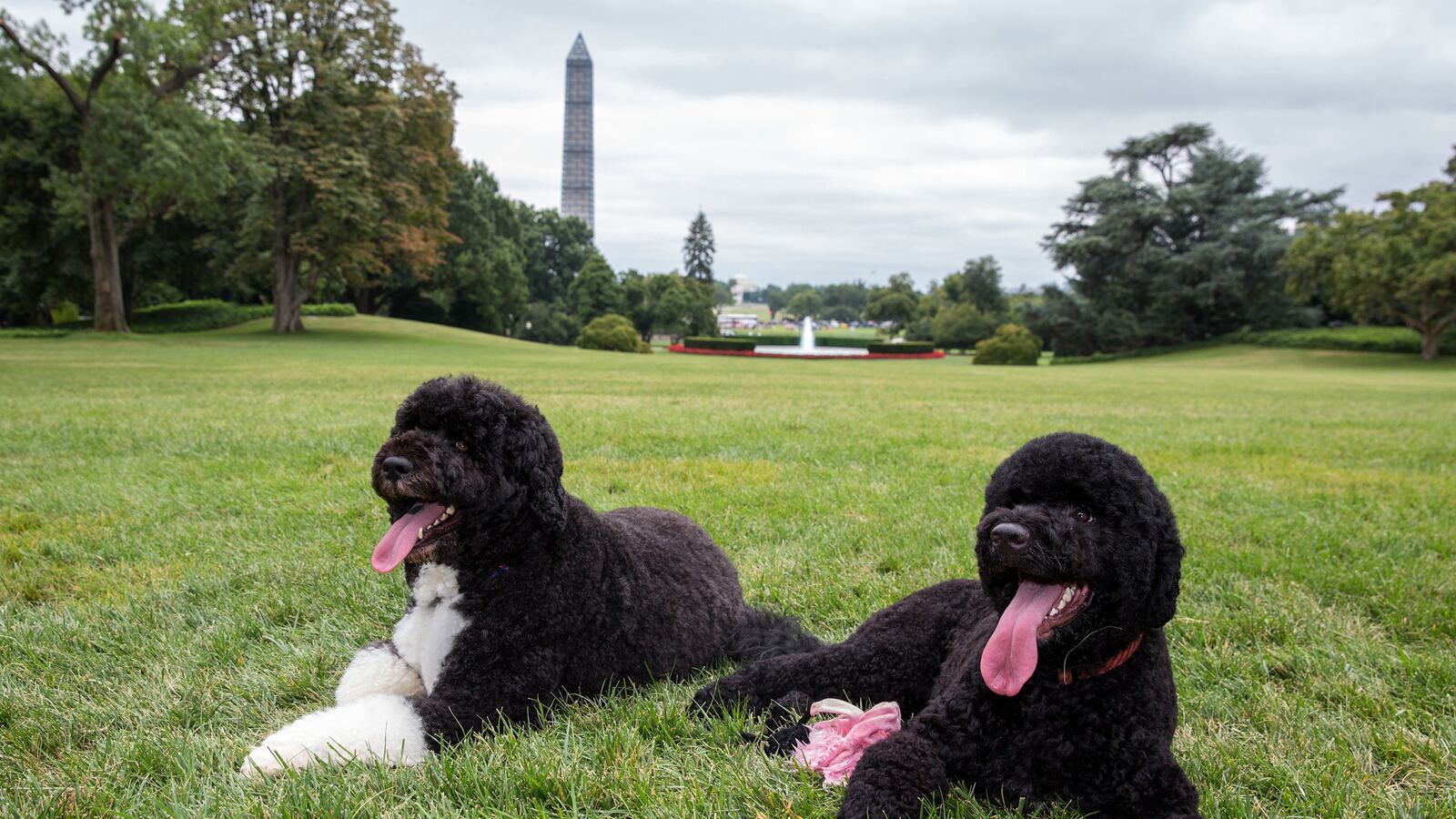While being the president’s dog might sound like the best pet gig ever, Bo’s life probably isn’t all it’s cracked up to be. Even lounging on Lincoln’s bed or lapping up leftovers off presidential porcelain can’t make up for living la vida sola, bereft of any conspecific companions.

That’s likely what the Obamas were thinking when they made the well-considered decision to add a second dog to the first family lineup: “Poor Bo shouldn’t have to go through life all alone. He needs a friend.”
The move makes a lot of sense. After all, it’s hard to imagine that a family life as travel intensive and demanding as the Obamas’ could be ideal for anyone, much less an animal whose natural social structure looks a whole lot more like the canine version of a raucous kindergarten class than the White House’s insulated existence. Dogs just aren’t meant to live in a bubble.
Enter Sunny, a 14-month-old female Portuguese water dog and, as of Monday, Bo’s official playmate. According to the White House’s blog post announcing the news, Sunny was so named for her disposition, a claim that’s hard to deny after watching video footage of both dogs at play on the White House’s iconic lawn, tongues a-lolling.
Though they appeared gloriously unscripted in their on-screen debut, make no mistake: this was no first romp. As protocol and prudence demand, this addition to the White House will have been as thoroughly vetted (or more) as anyone else our first family allows into their inner sanctum. How else to explain this “perfect match”?
Sunny’s arrival on Monday will have been the result of months of meticulous planning. She’ll have been one of many dogs chosen to audition for her place in American history as first pet. Her age, her demeanor, her gender, and her breed—not to mention her attitude toward Bo—reveal the many behind-the-scenes decisions that were made in advance of her first appearance.
That’s exactly what veterinarians like me love to see. Taking on a second dog isn’t as easy as they make it look on TV. Trust me, I see what happens when people assume it can be done on a whim. And as Sunny’s arrival underscores, there’s a lot that goes into making the decision to bring in a second dog. So it’s absolutely crucial that any prospective second pet understand the complex politics that attends them.
Above all, first know whether a second pet is right for you. Ponder these assorted pros and cons before you bite:
• Is your dog overweight? Underactive? Bored? A second may be just the thing.
• Two pets isn’t cheaper than one. As a veterinarian, I can attest that there’ll be double the damage come vet-time.
• Some preexisting unwanted behaviors may improve if a new dog helps the first feel more a part of a packlike social structure.
• Dogs with behavior problems, especially anxiety-based conditions, may not pair easily with others. In some cases they may even pass their condition along to their new pals.
• Travel much? It’s often more than twice as tough to travel with two.
• Second pets may be necessary for your emotional health, given that pet loss is inevitable.
Once you’ve decided you’re truly in the market, the questions of timing, breed, size, age, gender, and demeanor will naturally arise. But the answers probably won’t be as obvious as you’d assume. Here’s a quick primer:
Timing: In general, veterinarians, trainers, and behaviorists recommend waiting until your first dog has reached social maturity, which happens at around 2 years of age. At this point, your dog’s behavior stabilizes and you’ll be in a better position to know what he needs. For example, some dogs do not interact well with other dogs and you might not know it if she’s still socially immature.
Breed: While it might seem that dogs of the same breed would always pair up best, some big personality breeds have a way of butting heads with others of their ilk.
Size: Similar sizes are often recommended but this, too, depends on the dogs’ personalities. You’d be surprised at how often an outsize Napoleon complex can make up for physical heft.
Age: Here’s where age can be an unpopular topic. That’s because most people want young pups as accompaniments, whereas dog professionals tend to recommend full-grown pups like Sunny or older adults whose personalities are well established. How else to be sure the interaction you see now is the one that’ll persist?
Gender: It’s probably true that most dogs do best when paired with members of the opposite sex, but there’s lots of individual variation on that score, too.
Demeanor: If your dog is really submissive, do you really want a bully? If she’s a high-drive playing machine, why subject a couch potato to all that energy? Here’s where you’ll ideally get to know a variety of prospective partners. To be sure, there’s no substitute for allowing dogs to interact in advance of making any final decisions.
Now that you’ve found your fish in the sea—and there are so many to choose from!—it’s time to integrate them correctly. Here are a few choice “rules” dog professionals recommend:
• Separate them for feeding.
• Be fair when doling out treats.
• Try not to leave out toys considered highly desirable by both dogs.
• In general, try not to let them compete for any resource: food, treats, toys, beds, location on the couch, etc.
• Use the first dog as an example of “how to do it right” by rewarding her while he’s present.
• Crate training both dogs is a great way to head off problems of competition. It also offers both dogs a safe place to go should they be stressed by the newness of the interaction.
See? It’s not so straightforward. Professional assistance is always a great idea at times like these. I recommend you hire a behavior professional. (Ask your veterinarian for a recommendation.) It’ll go a long way toward giving you confidence that you’ve done the best thing for your pack.






